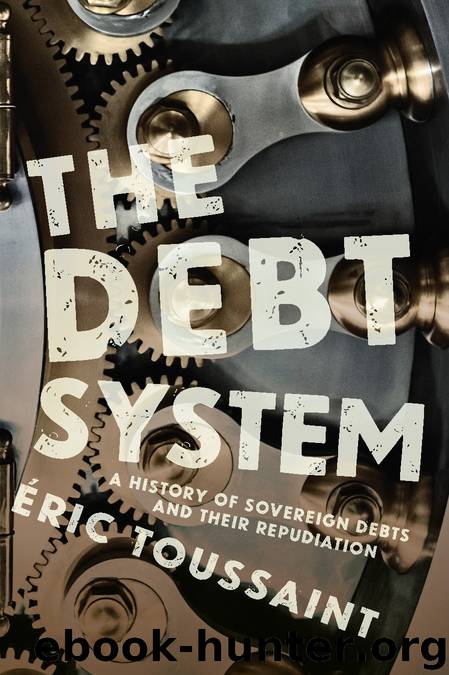The Debt System by Éric Toussaint

Author:Éric Toussaint
Language: eng
Format: epub
Publisher: Haymarket Books
Published: 2019-04-08T16:00:00+00:00
Chapter 10
Debt Repudiations between 1830 and 1930
Calling the legitimacy of debt into question and denouncing it as odious have been regular practices of government leaders who resorted to debt repudiation during the nineteenth and early twentieth centuries.
These concrete exceptions to the rule of continuity of contracts between a state and its creditors led Alexander Nahum Sack to define the conditions for calling a debt odious. From Sack’s point of view, the goal was to see to it that some order reigned with regard to acts of repudiation and to warn creditors of the risks they took in granting credits that might fall under the criteria for odious debt. This chapter sketches a panorama of debts that were repudiated during the period covered by Sack’s book.
A subsequent chapter will be devoted solely to the repudiation of tsarist debt by the Soviet government in 1918. Let us recall here that Sack considered this repudiation unjustified; he also felt that the Soviet government should have demanded that Poland repay part of the debts of the Russian Empire, which had annexed Poland, once it had been freed of the tsarist and German yoke after the First World War. The case of Mexico, which was discussed in a previous chapter and will be examined in the next one, will also not be mentioned in this chapter.
Portugal’s debt repudiation in 1837
After an armed struggle for succession that lasted from 1831 to 1834, Queen Maria of Portugal repudiated a loan issued in 1833 by the self-proclaimed king, Dom Miguel. She justified the repudiation by saying that bankers should not have lent money to a usurper. The loan had been issued in Paris in 1833 through the bankers Outrequin and Jauche for a sum of FF 40 million, to be repaid over thirty-two years at 5 percent interest. The bankers had not hesitated to take risks, organizing the launch of the bond issue even as the two armies in Portugal confronted each other over the succession to the throne.
As on previous occasions, the bankers had retained from the amount raised for Dom Miguel on behalf of Portugal the equivalent of eighteen months’ interest and paid it out to the bondholders. Once Dom Miguel was overthrown in 1834, his repayments naturally ceased. Queen Maria suspended repayment in 1835–1836 before repudiating the debt outright in 1837.
Bondholders set up a repayment committee that over fifty-four years initiated numerous actions to try to obtain repayment.1 In 1891, one of Maria’s successors finally agreed to pay a paltry amount, equivalent to FF 2.5 million (remember that the initial loan was for FF 40 million). Two and a half million was the amount Queen Maria had managed to recover from the treasury of Dom Miguel.
It is noteworthy that despite the suspension and repudiation of the debt and the ensuing protests, Portugal was able to float fresh loans in Paris and London as of 1836–1837. Although Portugal rapidly defaulted on these loans, between 1856 and 1884 fourteen further loans were issued, to the tune of £58.
Download
This site does not store any files on its server. We only index and link to content provided by other sites. Please contact the content providers to delete copyright contents if any and email us, we'll remove relevant links or contents immediately.
| Accounting | Economics |
| Exports & Imports | Foreign Exchange |
| Global Marketing | Globalization |
| Islamic Banking & Finance |
The Meaning of the Library by unknow(2532)
Six Billion Shoppers by Porter Erisman(2280)
Why Nations Fail: The Origins of Power, Prosperity, and Poverty by Daron Acemoglu & James Robinson(2254)
No Time to Say Goodbye(2080)
Red Notice by Bill Browder(2044)
The Economist [T6, 22 Thg9 2017] by The Economist(1901)
Currency Trading For Dummies by Brian Dolan(1899)
Thank You for Being Late by Thomas L. Friedman(1751)
Bitcoin: The Ultimate Guide to the World of Bitcoin, Bitcoin Mining, Bitcoin Investing, Blockchain Technology, Cryptocurrency (2nd Edition) by Ikuya Takashima(1674)
Amazon FBA: Amazon FBA Blackbook: Everything You Need To Know to Start Your Amazon Business Empire (Amazon Empire, FBA Mastery) by John Fisher(1550)
Coffee: From Bean to Barista by Robert W. Thurston(1503)
The Future Is Asian by Parag Khanna(1460)
The Great Economists by Linda Yueh(1439)
How Money Got Free: Bitcoin and the Fight for the Future of Finance by Brian Patrick Eha(1401)
Grave New World by Stephen D. King(1397)
Pocket World in Figures 2018 by The Economist(1397)
Capitalism Without Capital: The Rise of the Intangible Economy by Jonathan Haskel(1381)
The Sex Business by Economist(1361)
Cultural Intelligence by David C. Thomas(1273)
